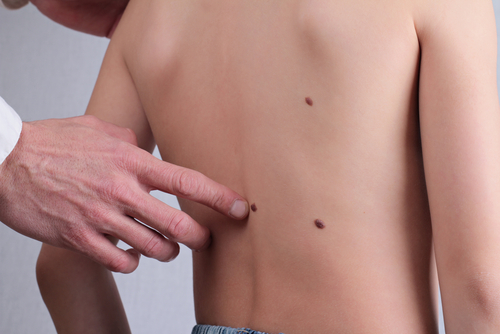A birthmark is a colored mark on or under a newborn baby’s skin. Some birthmarks show up soon after a baby is born. Most birthmarks are obvious at birth. Some kinds of birthmarks fade or go away as a child gets older. Others stay the same or get bigger, darker, or thicker.
What causes birthmarks?
Some birthmarks are from extra color (pigment) in the skin. Other birthmarks are blood vessels that are bunched together or don’t grow normally. It’s not clear why some children have birthmarks and others don’t.
Types
- Salmon patches (also called stork bites, angel kisses, and macular stains). Salmon patches are thin, flat, light pink or red birthmarks. They tend to be on the back of the neck, the upper eyelids, upper lip, or between the eyebrows.
- Congenital moles (nevi). Congenital moles can grow anywhere on the body. They vary in size and shape. Most are brown.
- Café-au-lait spots. Most café-au-lait spots are smooth, oval birthmarks. They range in color from light brown to chocolate brown and usually are found on the torso, buttocks, and legs.
- Mongolian spots. Mongolian spots are smooth, blue or blue-gray birthmarks. They are often uneven in shape and are on the lower back and buttocks.
- Hemangiomas. Hemangiomas are raised birthmarks. They are blue, red, or purple. They are clumps of blood vessels that didn’t grow normally. Hemangiomas grow in many shapes and sizes. They may grow only on the skin, or they may extend deeper into the body.
- Port-wine stains. Port-wine stains are birthmarks that are pink-red at birth and then become a darker red-purple. Port-wine stains are blood vessels that didn’t grow normally. They can be small, or they can cover a large area of the body.
Do birthmarks need to be treated?
Most birthmarks are harmless and need no treatment. Some will even fade or disappear over time. But in rare cases, birthmarks need treatment because they are growing quickly, growing on an internal organ, or causing a medical problem (such as a problem with sight, breathing, hearing, speech, or movement).
There are several ways to fade, shrink, or remove birthmarks. These include:
- Medicines, such as propranolol or corticosteroids.
- Laser therapy.
- Surgery.
Your options will depend on the type of birthmark, where it is, and what problems it’s causing. Treating a birthmark can be a big decision. The treatments may not work, and they can be painful and cause side effects.
If your child’s birthmark bothers or worries you, try not to let your child know how you feel. Ask others not to make a big deal out of it. If a birthmark upsets your child, it may help to have your child talk with a trusted doctor. If your child is still upset, talking to a counselor or support group may be a good idea to help him or her feel better.
If you see a birthmark on your baby, make sure that a doctor has seen it. Although most birthmarks are harmless, some aren’t.
If a birthmark grows, bleeds, hurts, or gets infected, see a doctor to have it checked.


